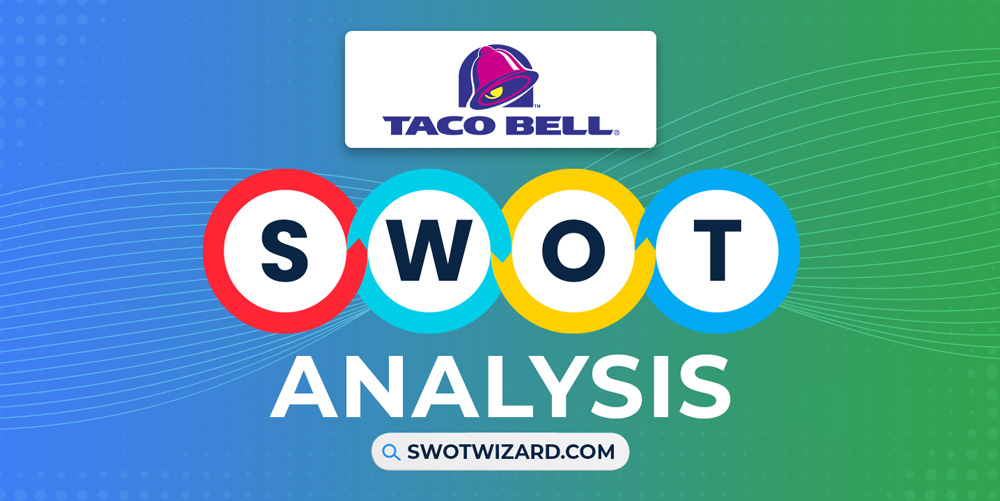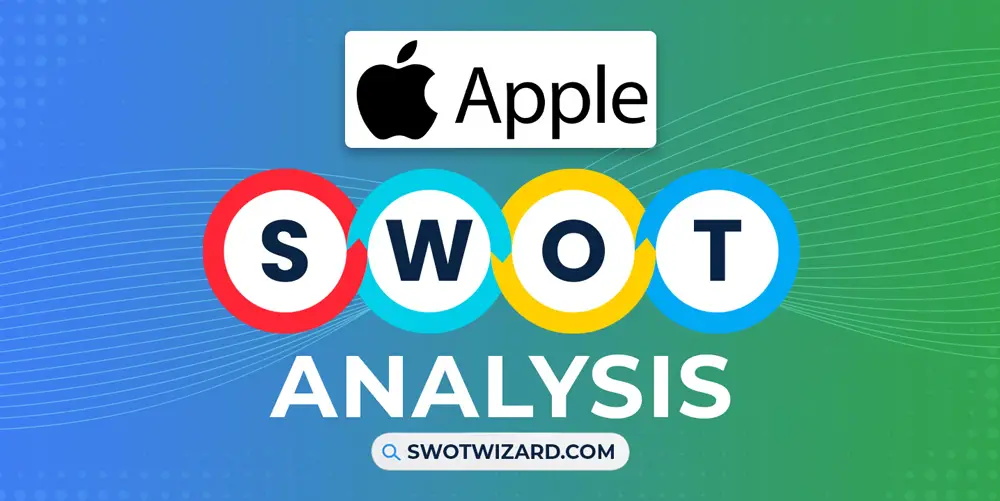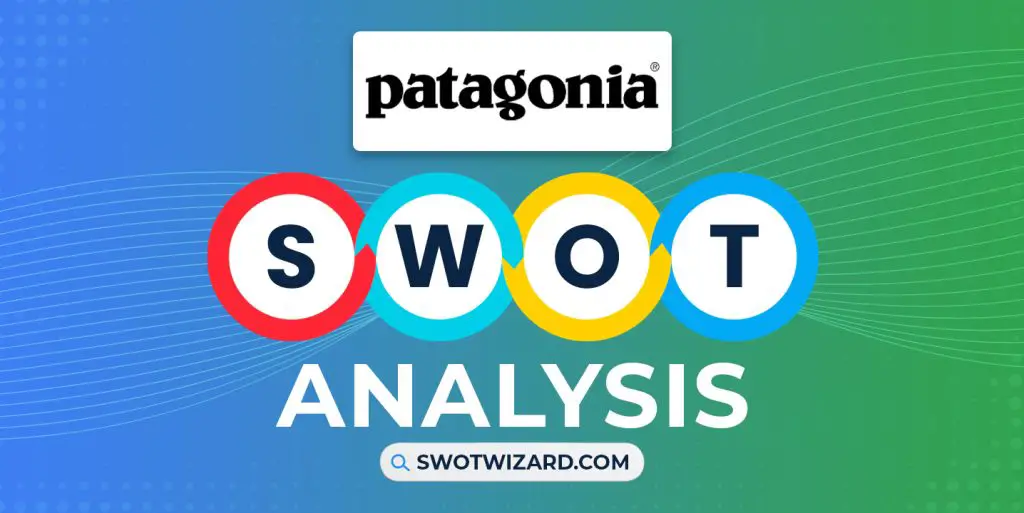Taco Bell is one of the most famous and is the type of restaurant that you will find on your street corner, serving the neighborhood every day. And, we will learn and discuss the company in this Taco Bell SWOT analysis.
Taco Bell: Company Overview
| Company | Taco Bell IP Holder, LLC |
| Industry | Restaurants |
| Founded | 21 March, 1962 |
| Founder | Glen Bell |
| CEO | Sean Tresvant |
| Headquarter | Irvine, California, U.S. |
| No. of Employees | 175,000+ |
| Annual Revenue | $1.988 billion (FY 2015) |
| Website | tacobell.com |
Originally founded in 1962, 60 years ago from now, by Glen Bell in Downey, California, Taco Bell became a cultural phenomenon in the 1980s and 90s with unique menu creations like the Crunchwrap Supreme and world-first vegetarian menu options.
With over 7,000 store locations as of 2022 across more than 30 countries and systemwide sales exceeding $13.5 billion last year, Taco Bell remains an influential global brand under parent company Yum Brands!
Currently ranking among America’s top five largest restaurant chains, Taco Bell proudly employs over 200,000 team members, providing quality Mexican-inspired fare customized for local tastes worldwide.
Product & Services of Taco Bell
Tacos | Burritos
Taco Bell Competitors
Chipotle | Taco John’s | Taco Cabana | Del Taco | Chick-Fil-A | Wendy’s
Did You Know?
In 1998, Taco Bell experimented with serving French toast sticks and iced coffee drinks for the breakfast menu.
Strengths – Taco Bell SWOT Analysis
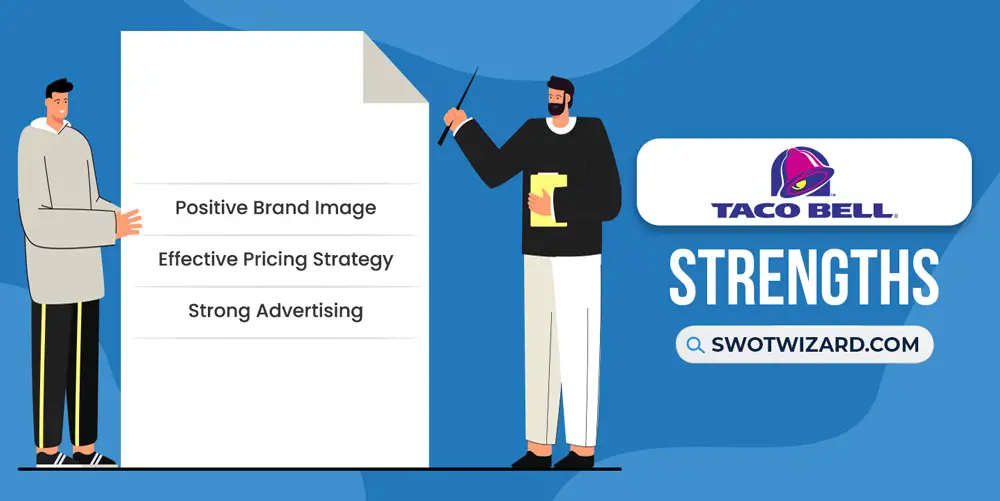
Positive Brand Image: The company has cultivated a fun, approachable brand image that resonates with its target young adult demographic. As a result, It is evident in its marketing campaigns and engagement on social media platforms, where Taco Bell has over 1.9M Twitter and 1.5M Instagram followers.
Effective Pricing Strategy: By offering affordable combo meals and dollar menus, Taco Bell is a go-to for budget-friendly Mexican fast food. According to recent data, the average Taco Bell order costs just $8.79. As a result, the competitive pricing helps drive customer traffic, especially among college students and others with limited incomes.
Strong Advertising: Taco Bell uses entertaining TV and digital advertising effectively to promote new product launches and keep the brand in mind. In 2023, Taco Bell spent over $100M on advertising in the US. Besides, their ads have proven successful, building hype and engagement among fans.
Weaknesses – Taco Bell SWOT Analysis
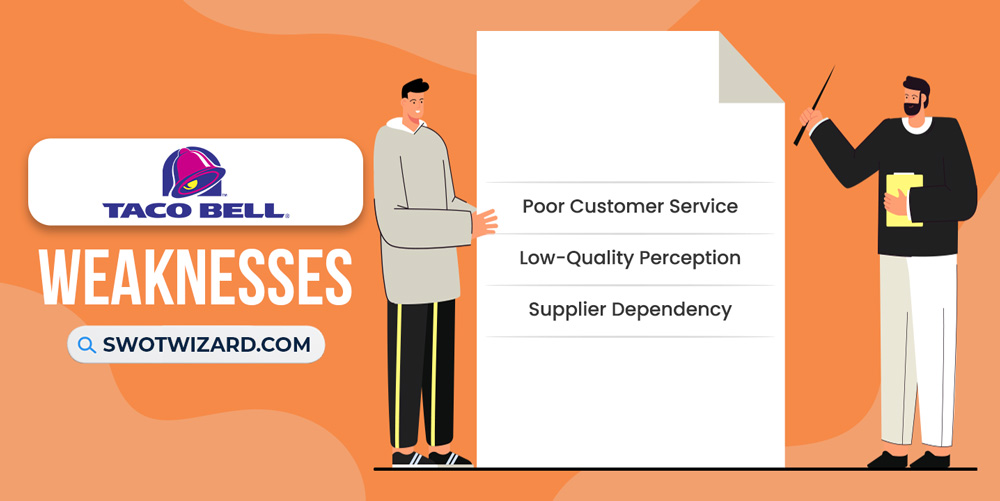
Poor Customer Service: The company has recently fallen behind competitors in customer service ratings. Per the 2023 American Customer Satisfaction Index report, Taco Bell ranks lowest among major USA fast food chains in customer satisfaction with a score of 70/100, and it could damage the long-built image of the brand and affect revenue.
Low-Quality Perception: Despite new menu innovations, Taco Bell still struggles with a reputation for serving inexpensive, lower-quality ingredients compared to competitors. According to the data, only 41% of consumers see Taco Bell as a higher-quality brand, according to 2022 YouGov polling data.
Supplier Dependency: Taco Bell relies heavily on critical suppliers for ingredients, which exposes the company in the supply chain. As a result, over 85% of its beef comes from just two American suppliers, making shortages a constant risk. Besides, supply issues have forced some locations to experience ingredient outages in recent years.
Opportunities – Taco Bell SWOT Analysis

Market Expansion: Taco Bell plans to build over 950 new international locations by 2026, expanding further into India, China, Brazil, Italy, Spain, and parts of Northern Europe, where Mexican-inspired food demand is surging and projected to grow up to 8% annually. Besides, it’s high time to firmly leverage the brand image and stabilize the cash flow.
Better Offerings: Sales of plant-based foods grew over 3 times faster than total food sales from 2018 to 2023, according to data. By diversifying plant-based protein and menu item options focused on flexitarian and vegan diets, Taco Bell can tap into consumer demand better, and it will help the company grow and expand.
Trained Workforce: According to the data, 85% of disabled consumers report difficulties accessing or ordering from restaurants per 2022 survey data. A broader customer pool opens up by training staff on assistive ordering technology and designing more disability-friendly locations, which also gives the company a better angle from marketing, PR, and CSR.
Threats – Taco Bell SWOT Analysis
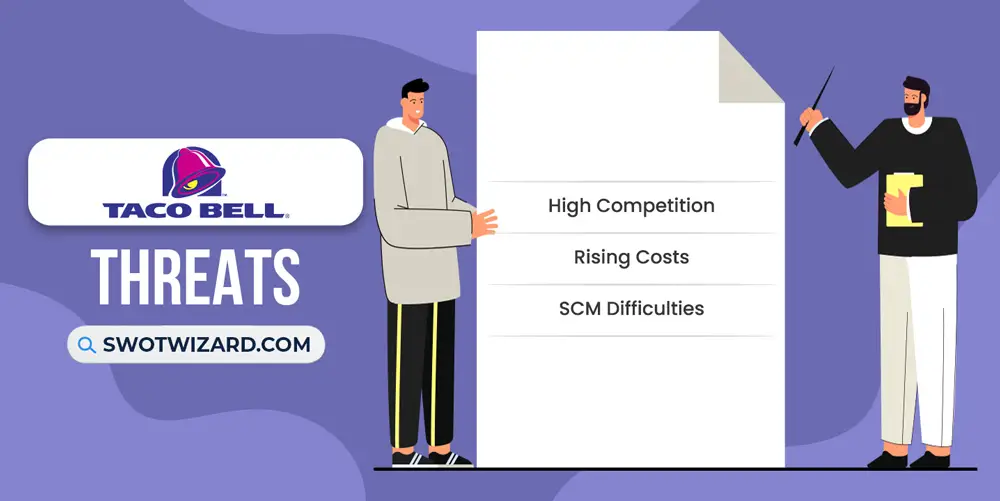
High Competition: The Mexican fast food space has become highly competitive, with chains like Chipotle and Moe’s claiming over 20% of the category share. According to market research data, although Taco Bell’s revenue is stable, the systemwide sales slipped around 2% behind rivals in the last few years.
Rising Costs: Like all restaurants, rising wholesale food costs and higher minimum wages present headwinds for Taco Bell. As a result, commodity costs were up over 8% for its parent company, Yum! Brands in 2023, while average hourly wages climbed over 15% since 2019.
SCM Difficulties: As a massive purchaser of ingredients like cheese, lettuce, and beef, interruptions from suppliers have significant ramifications for Taco Bell in the form of shortages and inflation. If we look at the data from the last few years, supply issues in spring 2022 forced changes to ingredients, raising the overall cost.
[Bonus Infographic] SWOT Analysis of Taco Bell
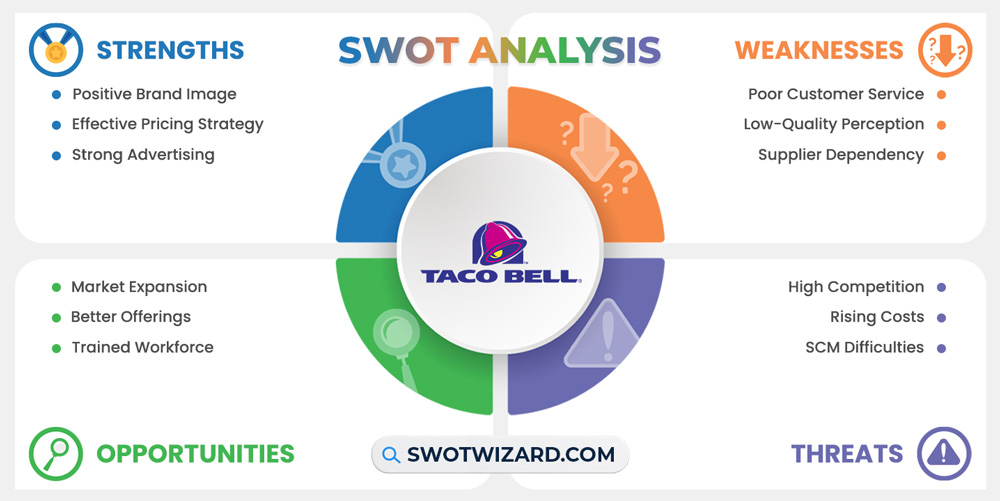
Recommendations for Taco Bell
Here are some recommendations for Taco Bell for the coming years.
- Maintain aggressive international store growth but focus expansion efforts on more company-owned stores.
- Respond to the rise of plant-based diets with meatless or tofu-based substitute options, more fresh produce offerings, and sustainable packaging.
- Expand staff training on superior customer service, efficiency best practices, and cultural inclusiveness for differently-abled, immigrant, and diverse guest experiences.
- Modernize digital technology infrastructure to enable seamless mobile ordering and payments, in-store automated kiosks, and predictive loyalty programs.
Frequently Asked Questions (FAQs)
Is Taco Bell bigger than McDonald’s?
No, Taco Bell isn’t bigger than McDonald's.
Is Taco Bell 100% meat?
No, Taco Bell isn’t 100% meat.
Final Words on Taco Bell SWOT Analysis
Taco Bell retains brand strength among loyal young fans but faces intensifying competition in the Mexican fare space. Strategic global expansion of company-owned stores, advances in plant-based and dietary-accommodating menu innovation, improved technology use around predictive personalization and accessibility, plus dedicated staff training on empathy and serving better are advisable.
References
- Wikipedia contributors. (n.d.). Taco Bell. Wikipedia.

